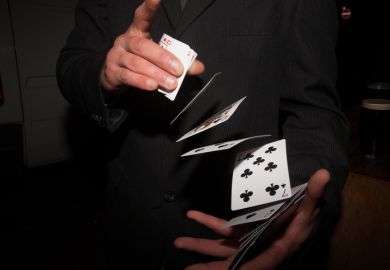At the official launch of the Institute for Research in Schools (Iris), held at the Science Museum in London at the beginning of this month, director Becky Parker spoke of her “vision to empower [schoolchildren] to be part of the scientific community”. She wanted to see them “experience the thrill of discovery” and “get stuck into big, meaty projects” rather than just repeating experiments that have been done a thousand times.
Her presentation was followed by examples of pupils describing the powerful research they had carried out in areas such as tracking radiation levels in space and at sea (using detectors provided by Cern), the early diagnosis of Alzheimer’s disease and the prevalence of diabetes in London’s Bangladeshi community.
Parker, head of physics at the Simon Langton Grammar School for Boys in Canterbury (which admits girls in the sixth form), is also a visiting professor at Queen Mary University of London. She has long been a pioneer in getting her pupils to do “real science”, a model that the new institute is rolling out across the country.
There are many benefits, she argues, in producing “young people who can speak in public, communicate, code, write up scientific papers. It is really about valuing the potential of young people – normally there is so little scope for them to feel that science is an open field they can contribute to at that age.”
Taking part in research promotes scientific literacy and encourages more young people to study science, technology, engineering and mathematics subjects and, perhaps, to pursue scientific careers, she says. Girls in particular “love getting into stuff in this way”, one of the reasons Parker believes her school punches "far above our weight in terms of the number of girls going on to study physics at university”. Science teachers in schools also tend to “jump at the chance to do something exciting, innovative and at the forefront of research”.
The Iris initiative enjoys the support of many academics keen to promote such goals and who are often impressed by the real advances in knowledge being made by some of the teenage researchers.
Matthew Holley, professor of sensory physiology at the University of Sheffield, has worked with pupils at the local Tapton School as part of the wider Wellcome Trust-funded Authentic Biology stream of school-based research.
Here he has helped to oversee a project where “students do cardiovascular research based on a zebrafish model. We ask them to take a gene expression from the blood of patients at risk of a heart attack and see which genes are differentially expressed.”
Although the university has to provide the fish material, because it is not permitted to kill fish in schools, the young research team “does all the labelling and interpretation and has identified an enzyme which could be interesting”. The research is now being developed further in the university laboratory, with many of the pupils brought in as volunteers to work alongside postdocs. They have already, in Holley’s view, acquired crucial transferable skills in “building and testing hypotheses” and “dealing with uncertainty”.
Steven Rose, head of the Plasma Physics Group at Imperial College London, was himself a pupil at the Simon Langton school and returned to give a talk there in 2007. That led him to “set up a research project, exactly like I would have done with a PhD student”.
He therefore comes up with a suitable unsolved problem and presents it to the lower-sixth physics class, “talking through the issues, pointing to the literature and a possible direction to take – and then asking them to come back with an answer”.
Although some pupils inevitably just “wander off”, others take up the challenge with their teacher as mentor. Rose in essence leaves them to it, making himself available by email or occasional visit and maintaining “a similar level of contact as I have with my PhD students”.
One particular puzzle concerned “whether it is possible to understand the shape of a distant plasma from the radiation it emits”. One particularly talented pupil ran with this, came up with “a very elegant, simple solution which [Rose] hadn’t found” and published the results in a solo-authored journal paper that Rose was delighted to hear someone refer to as a major contribution at a conference.
Along with providing genuine additions to knowledge, he believes that “encouraging an interest in the subject” through such projects is more effective than “requiring them to jump through a lot of hoops” in persuading more schoolchildren to pursue scientific degrees and careers.
If they go on to interviews at universities, he points out, “they can talk about research areas they know more about than the people interviewing them – it gives them huge confidence”.
POSTSCRIPT:
Print headline: Teens tempted with the ‘thrill of discovery’
Register to continue
Why register?
- Registration is free and only takes a moment
- Once registered, you can read 3 articles a month
- Sign up for our newsletter
Subscribe
Or subscribe for unlimited access to:
- Unlimited access to news, views, insights & reviews
- Digital editions
- Digital access to THE’s university and college rankings analysis
Already registered or a current subscriber?




